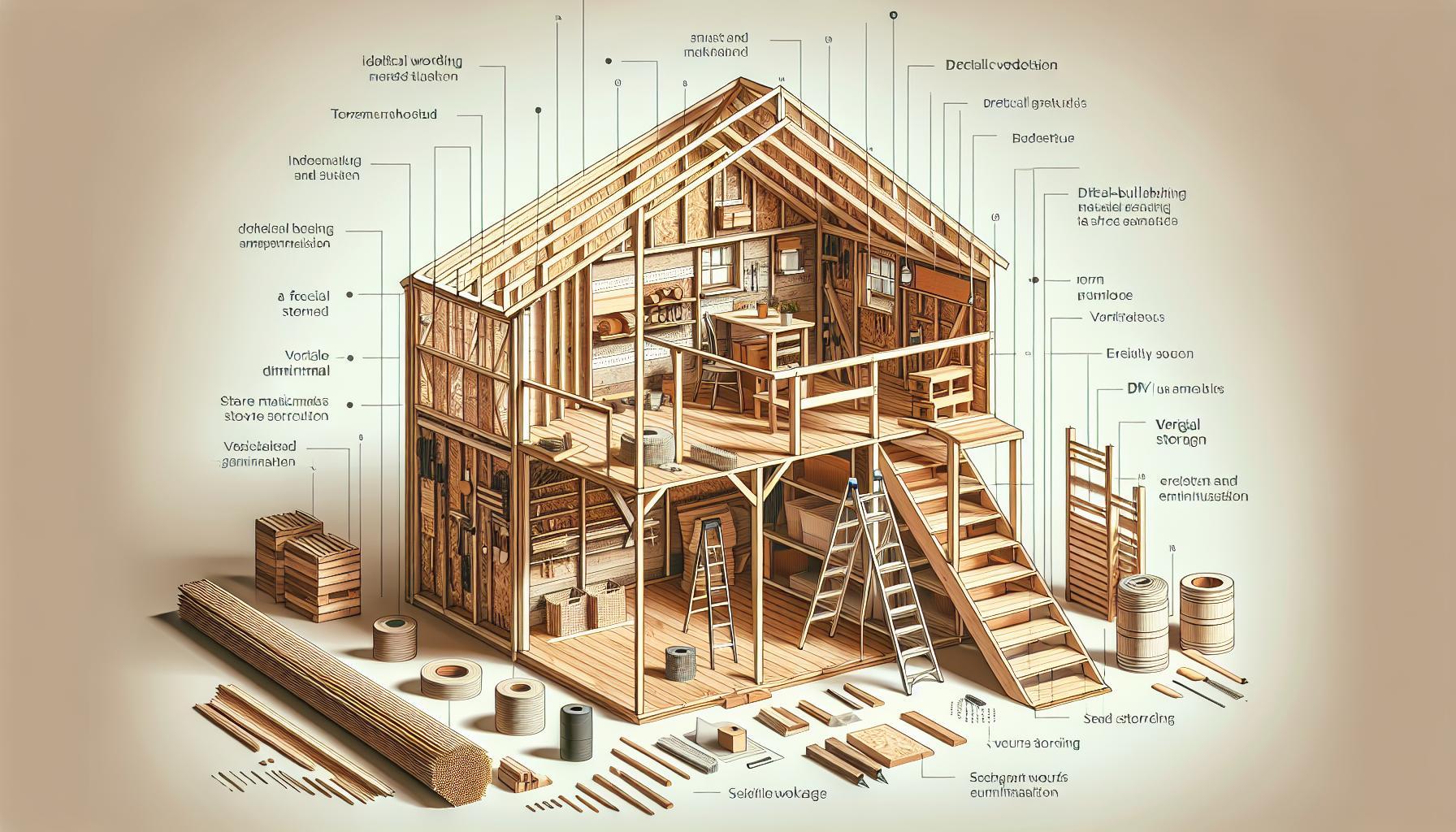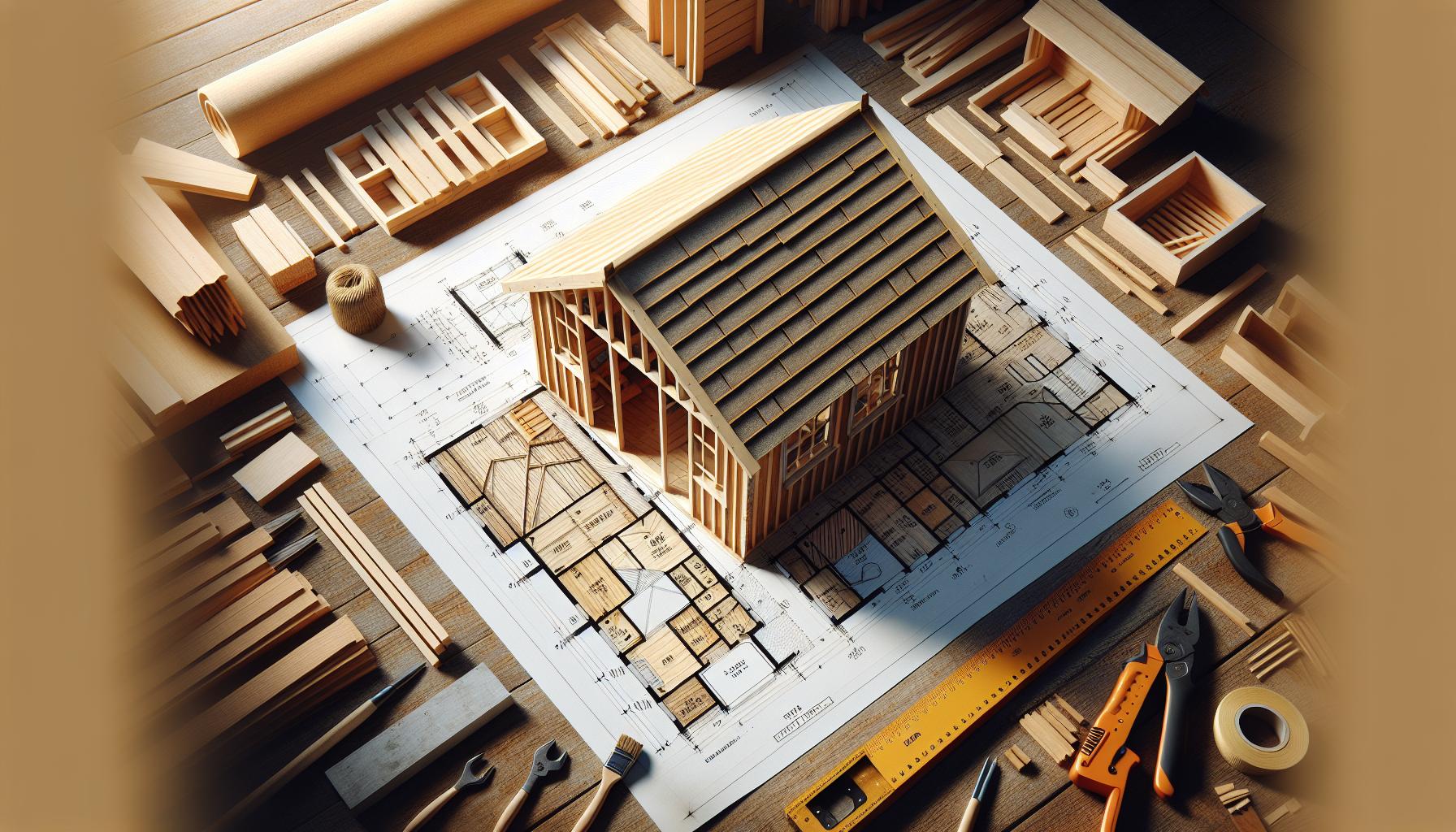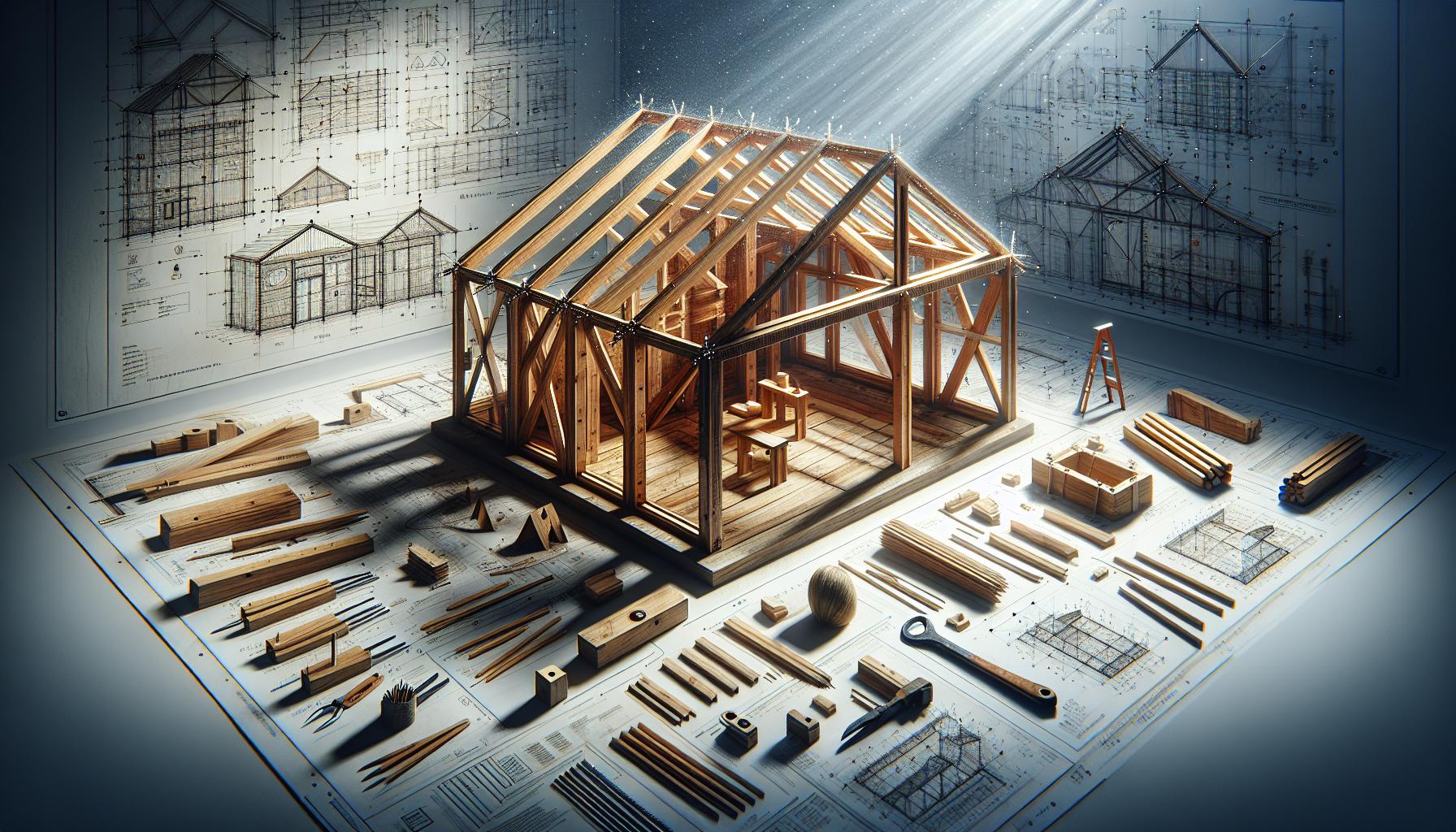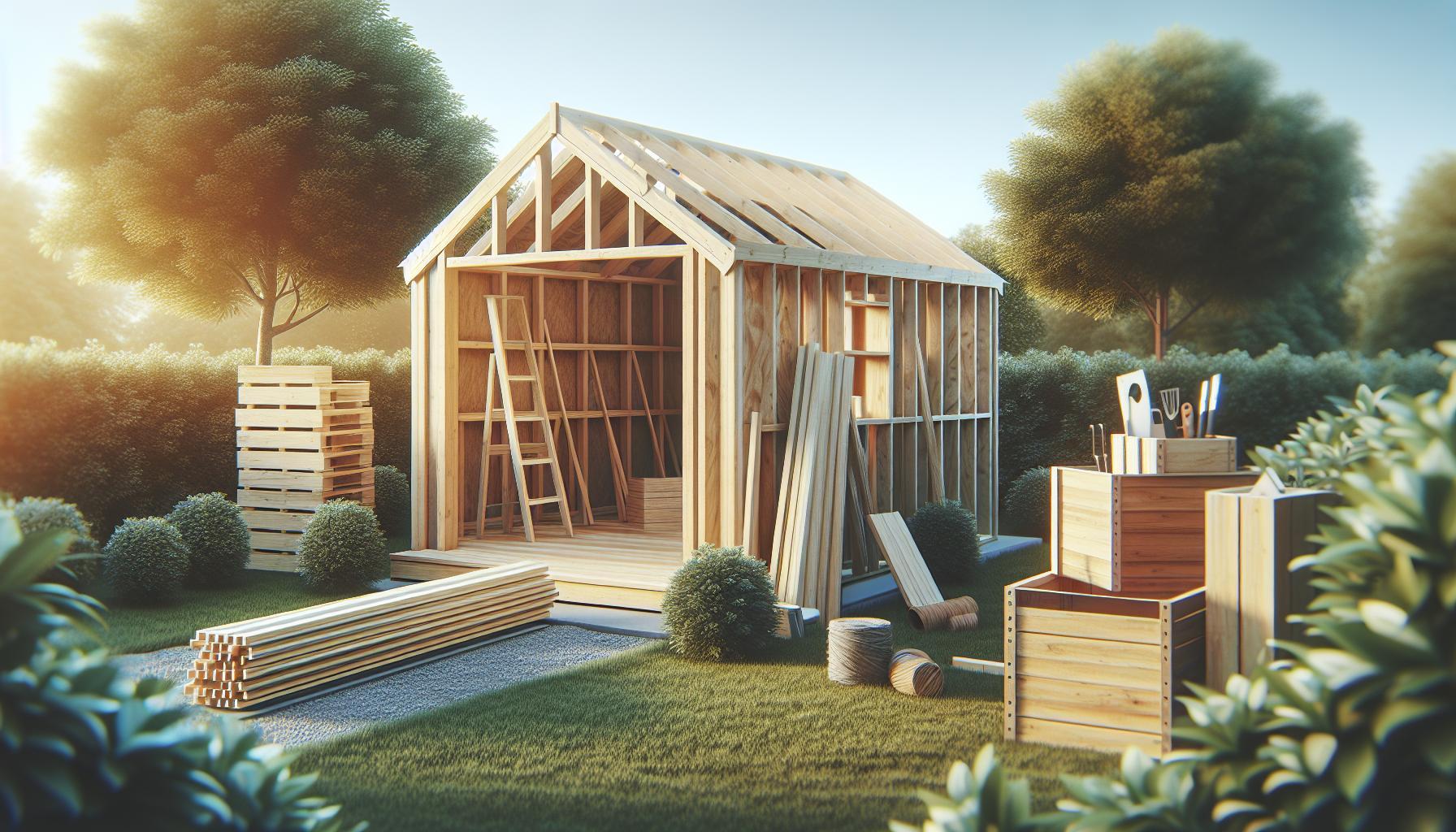Maximizing storage space in yoru outdoor shed can be a daunting challenge, especially when dealing with limited floor area. Building a multi-level shed offers a practical solution, allowing you to utilize vertical space efficiently. This approach not only enhances association but also transforms your shed into a functional and versatile workspace, making it essential for homeowners seeking to optimize their outdoor storage.
Understanding the Basics of Multi-Level Shed Design
Designing a shed with multiple levels opens a realm of possibilities for maximizing space and enhancing organization. This approach not only allows you to store more items effectively but also ensures that everything has its place, reducing clutter and improving accessibility. By embracing vertical storage, you can transform a standard garden shed into a multifunctional workspace that meets various storage needs, whether for gardening tools, seasonal decorations, or hobby supplies.
Key Considerations for Multi-Level Design
When contemplating a multi-level shed design, consider the following factors to ensure optimal functionality and safety:
- Weight Distribution: Ensure that the structure can support additional levels. Use sturdy materials and distribute weight evenly to avoid sagging or structural damage.
- Access points: Plan for easy access to all levels. Incorporate sturdy ladders or stairs that are safe and make regular use convenient.
- Ceiling Height: Assess the height of your shed. higher ceilings may allow for more levels and storage opportunities without making the space feel cramped.
- Lighting: Implement proper lighting to enhance visibility in multi-level areas, making it easier to locate items stored on higher shelves or in darker corners.
Effective Vertical Storage Strategies
Utilizing vertical space efficiently is integral to any multi-level shed design. Here are some actionable strategies:
- Adjustable Shelving: Incorporate adjustable shelves that can be moved or repositioned according to your storage needs.This adaptability allows you to accommodate various items, from small tools to large bins.
- Hooks and Pegboards: Install hooks or pegboards on walls to hold tools vertically, saving shelf space and making it easy to grab essentials quickly.
- Bins and Baskets: Use labeled bins and baskets to organize small items. Place them on upper shelves to keep them out of the way while still accessible.
- Overhead Racks: Consider adding hanging storage racks near the ceiling for rarely used items, like seasonal decorations or camping gear.
Example of a Multi-Level Shed Layout
To visualize how you might structure a multi-level shed, the following table outlines a sample layout:
| Level | Purpose | Storage Solutions |
|---|---|---|
| Ground Floor | Daily use tools and equipment | Shelves, hooks for tools, tool cabinet |
| Mid Level | Gardening supplies and small appliances | Adjustable shelving, labeled bins |
| Upper Level | Seasonal and seldom-used items | Overhead racks, storage bins |
Incorporating these elements into your shed design will not only help you achieve a clean and organized space but also allow you to make the best use of the available vertical space. Ultimately, a well-planned multi-level shed can significantly enhance productivity and ease of access to your outdoor supplies and tools.
Essential Materials and Tools for Your Vertical Storage Project
When embarking on a vertical storage project, selecting the right materials and tools can enhance both functionality and aesthetics. Vertical storage not only maximizes space but also organizes your belongings more efficiently. Whether you’re considering building a multi-level shed or optimizing an existing space, having an arsenal of essential resources at your disposal is crucial.
Key Materials
To construct a robust vertical storage solution, you must start with durable materials. Here are some essentials:
- Structural Wood: Quality lumber is fundamental. Choose treated wood for areas exposed to moisture, and opt for plywood for shelves that need to support weight.
- Metal Brackets: Use strong metal brackets to reinforce shelves and optimize weight distribution.
- Storage Bins and Baskets: These help categorize and contain items, making retrieval quick and easy while keeping the aesthetic clean.
- Safety Equipment: Safety gear, including gloves and goggles, ensures you remain protected while working on your project.
Crucial Tools
Having the right tools can make or break your vertical storage project. Consider gathering the following tools:
- Power Drill: A reliable drill is necessary for making clean holes and driving screws effectively.
- Level Tools: A level ensures your shelves and structures are perfectly horizontal, which is vital for both aesthetics and functionality.
- measuring Tape: Accurate measurements are critical in preventing space miscalculations; invest in a quality measuring tape.
- Saw: A power saw allows for quick and precise cutting of wood or metal materials needed for your project.
By using the right combination of sturdy materials and efficient tools, anyone can transform their storage spaces through vertical maximization techniques. As you engage with the project,think about your unique storage needs and plan accordingly. With thoughtful preparation, you can create a multi-level shed that not only elevates your storage capabilities but also serves as a stylish addition to your property.
Step-by-Step Guide to Planning Your Shed Layout
To create a well-organized and efficient shed layout, it’s essential to consider the vertical space available for storage. A multi-level approach can significantly enhance the amount of usable space, allowing you to keep your tools and equipment neatly organized while maximizing every square inch of your shed. By planning effectively, you can transform your shed into a functional storage area that meets all your needs.
Assess Your Needs
Begin by evaluating what you intend to store in your shed. Take an inventory of the items you currently own and any that you plan to add in the future. Group similar items together, such as gardening tools, seasonal decorations, or sports equipment. This initial assessment not only helps to visualize the layout but also facilitates decisions regarding the type of shelving and storage solutions you might need.
consider the following questions:
- Which items do you use most frequently?
- What items are bulky or oddly shaped?
- Do you need space for larger equipment or vehicles?
Create a floor Plan
Once you have a clear understanding of what needs to be stored, it’s time to sketch a basic floor plan of your shed. You can use graph paper or online tools to help visualize the space. Mark where windows and doors are located, as this will affect the placement of shelves and larger items.
Identify designated zones within your shed:
| Zone | Items to Store | Suggested Storage Solutions |
|---|---|---|
| Tools | Hand tools, power tools | Wall-mounted pegboards, tool hooks |
| Gardening Supplies | Fertilizers, pots, soil | Stackable bins, shelves |
| Seasonal Storage | Holiday decorations, winter gear | Overhead racks, clear bins |
Utilize Vertical Space
Implementing vertical storage maximizes utility by utilizing otherwise wasted vertical space. Consider installing shelving units that go up to the ceiling and include adjustable shelves to accommodate items of various sizes. Hanging storage solutions, such as hooks or racks, can efficiently store larger tools or bicycles, keeping the floor clear for other uses.
Additional Tips:
– Use stackable storage boxes for items that are seldom used; label each box for easy identification.
– Incorporate a ladder or shelving system that allows you to easily reach higher storage areas.
– Use wall-mounted magnetic strips to store small metallic tools.
With a thorough plan that emphasizes both organization and space optimization, you can successfully create a multi-level shed that meets your storage needs. By thoughtfully approaching your layout and considering vertical storage options, you will enhance your shed’s functionality and ease of use, ensuring it serves you well for years to come.
Creative Storage Solutions for Multi-Level Shelving
Maximizing space in a multi-level shed requires innovative storage solutions that utilize vertical height effectively. Multi-level shelving not only helps to keep your materials organized but also allows you to access and store items conveniently, making your shed a functional hub. One of the key strategies involves integrating modular shelving that can adapt to your changing storage needs. These shelves can be easily adjusted,removed,or added as necessary,allowing for a flexible storage solution that evolves with your requirements.
Utilizing Vertical Space
To optimize vertical storage in your multi-level shed, consider these creative storage solutions:
- Wall-mounted Shelves: Install shelves that cling to the walls, allowing you to keep the floor space open for larger items. These shelves can be mounted at various heights to accommodate a range of storage needs from small tools to larger equipment.
- Pallet Racking: Using industrial-style pallet racks can significantly increase storage capacity. These racks can hold heavier items and come in various heights, making them ideal for a multi-level environment.
- Overhead Storage Bins: Make use of ceiling space by installing bins or storage containers overhead. This keeps less frequently used items out of sight yet accessible when needed, ensuring that your floor space remains uncluttered.
- rolling Carts: Incorporate rolling carts that can slide under shelves or out from corners to provide additional storage when needed, and can be moved freely for ease of access.
Multi-Level Design Considerations
In your quest for effective vertical storage, consider the following design tips for your multi-level shed:
- Adjustable Shelving: Install shelving units with adjustable heights to accommodate different sizes of storage items.This ensures that every inch of vertical space is utilized effectively.
- Color coding and Labeling: Use color coding and clear labels on boxes and bins. This practice not only aids organization but also speeds up retrieval, especially valuable in a busy environment.
- Access Points: Plan for easy access to all levels of shelving. Ladders or step stools should be easily accessible to avoid accidents and ensure safety when reaching for items stored at height.
By prioritizing vertical storage in your multi-level shed, you maximize your available space while keeping your tools and supplies organized and within easy reach. Implementing these creative storage solutions can transform a cluttered shed into a well-structured area that enhances efficiency and functionality.
Overcoming Common Challenges in Multi-Level Shed Construction
One of the most rewarding aspects of building a multi-level shed is the opportunity to optimize vertical space, ensuring that every nook and cranny is utilized effectively. However, embarking on this construction journey presents several challenges that can deter even the most enthusiastic DIYers. Understanding how to overcome these hurdles can make the difference between a cluttered space and an efficient, well-organized shed that meets your storage needs.
Designing for Stability
One key challenge in multi-level shed construction is ensuring structural integrity. As you stack levels for storage, you’re introducing additional weight that the base must support. To address this, consider materials that offer both strength and lightness, such as engineered wood or steel frames. Reinforcing the corners with additional brackets or cross-bracing can also enhance stability. Moreover, ensure your foundation is robust, as a solid base is crucial for any multi-level structure.
Maximizing Vertical space without Sacrificing Accessibility
Another common issue is accessibility. When creating multiple levels, it’s vital to incorporate design elements that allow you to reach stored items easily. Options include:
- Built-in shelves: Use adjustable shelving systems that can be repositioned based on your changing storage needs.
- Ladders or staircases: Integrate foldable or pull-out ladders that do not obstruct lower-level storage.
- Clear labeling: Every shelf and storage bin should have clear labels to ensure quick identification of tools and supplies.
implementing smart storage solutions, like using bins with wheels or crates that slide out, can also facilitate easier access to your items.
Maintaining Ventilation and Light
Multilevel sheds can frequently enough feel cramped, which may lead to issues with ventilation and natural lighting. To combat this, ensure that your shed has adequate ventilation options to prevent moisture buildup.Installing vents or windows will help circulate air and brighten the interior, making it more inviting for you to access stored items regularly. Consider using skylights or reflective surfaces to enhance brightness without taking up valuable wall space.
By facing these common challenges head-on, you can successfully construct a multi-level shed that not only maximizes your vertical storage but also provides a functional, accessible, and pleasant environment for all your tools and supplies.With careful planning and execution—as outlined in *Can You Build a Multi-Level Shed? Vertical Storage Maximization Tips*—the rewards of your hard work will be evident in both the organization and practicality of your shed.
Safety First: Building a Stable and Secure Structure
Building a multi-level structure, such as a shed, offers an exciting opportunity to maximize vertical storage; however, it also introduces challenges that must be carefully navigated to ensure safety and stability. A well-constructed multi-level shed not only provides ample room for tools and equipment but also enhances the longevity of the structure when built following safety best practices. Understanding the importance of a solid foundation and robust framework is critical to achieving a secure build.
Prioritize a Strong Foundation
The foundation serves as the backbone of your multi-level shed.It is essential to select a foundation type that fits the climate and soil conditions in your area. Such as, in regions with heavy rainfall, a poured concrete foundation may be more effective than a wooden option to prevent water damage. Here are some foundation options to consider:
- Poured concrete slab: Ideal for durability and moisture resistance.
- Concrete blocks: Provide good ventilation and are easy to adjust for uneven ground.
- Skids: Ideal for temporary structures and can be easily repositioned.
Ensuring that your foundation is perfectly leveled will create a stable base for your vertical storage. This foundational security prevents issues such as leaning walls or structural instability,which can become dangerous when multiple levels are introduced.
Safeguarding Your Structure
Once the foundation is secured, attention should turn to the walls and roof of the shed. Utilizing quality materials that are resistant to rot and pests can significantly enhance the lifespan of your shed. Consider the following structural elements:
- Reinforced framing: Use 2×4 or 2×6 lumber for framing additional stability when supporting multiple levels.
- Cross-bracing: Incorporating diagonal braces can prevent swaying and add to the structural integrity.
- Weatherproof roofing: Invest in materials that will withstand your local climate and prevent leaks.
Adding proper anchoring systems, like hurricane ties for the roof, can also enhance structural safety by securing the roof to the walls, thereby preventing accidental detachment during storms or high winds.
Implement Safety Features
As you maximize your vertical storage, it becomes crucial to incorporate safety features that mitigate risk. Here are some recommendations:
- Non-slip surfaces: Use textured materials or coatings on floors and staircases to prevent slipping.
- Secure storage solutions: Install heavy-duty shelving and storage bins that can securely hold items while also allowing for easy access.
- Regular maintenance: Schedule routine inspections to look for signs of wear or instability, ensuring you address any issues before they escalate.
Incorporating these measures will not only ensure compliance with any local building codes but will also provide peace of mind, knowing that you have built a safe, functional, multi-level shed.
Adhering to these principles while answering the question of whether you can build a multi-level shed emphasizes that with proper planning and execution, it is indeed indeed possible to create a safe and stable structure that maximizes vertical storage effectively.
Customizing Your Shed: Personal Touches for Function and Style
When it comes to enhancing the functionality and aesthetics of your storage space,customizing your shed offers a myriad of possibilities.From clever organization solutions to unique design touches, personalizing your shed can elevate its utility while reflecting your individual style. Incorporating multi-level storage systems is one effective way to maximize vertical space, making it easier to sort and access your belongings while keeping the area tidy.
Functionality Through Custom Features
Incorporate shelving and drawers to make the most of the vertical space in your shed. Consider adjustable shelving units that allow you to modify the height and arrangement based on changing storage needs. Utilize wall-mounted pegboards or hooks to keep tools and frequently used items within easy reach. This not only optimizes space but also enhances the overall flow and accessibility of your shed. Here’s a breakdown of essential storage solutions:
| Storage Solution | Description |
|---|---|
| Shelving Units | Adjustable shelves for varying heights of items. |
| Overhead Storage | Use rafters or ceiling-mounted shelves for seasonal items. |
| Wall Hooks | Great for hanging tools and keeping the floor clear. |
| Drawer Systems | Ideal for storing small items and keeping them organized. |
Adding Personal Touches
Besides functionality, personalizing the exterior and interior of your shed can significantly enhance its appeal. consider painting the shed in a color that complements your home or landscape. Adding decorative trim,window boxes filled with flowers,or even string lights can create a cozy atmosphere. Inside, you could install a small workbench or display area for gardening tools, paintings, or crafts, providing a space that reflects your hobbies and passions.
To make your shed a true extension of your home, you might also think about incorporating smart storage solutions that blend both functionality and style. Such as, use stylish wicker baskets on shelves for storing items while adding a decorative touch. By focusing on both storage capacity and visual appeal, you can create an inviting space that is organized and showcases your unique personality, which is a perfect response to the question: “Can You Build a Multi-Level Shed? vertical Storage Maximization Tips.”
customizing your shed with thoughtful features not only maximizes storage but also creates a personalized sanctuary that serves your needs and preferences.Whether through strategic shelving, colorful aesthetics, or other innovative storage solutions, every choice can be a reflection of you.
maintenance Tips to Keep Your Multi-Level Shed in Top Shape
Maintaining a multi-level shed is crucial for maximizing both its functionality and lifespan.Just as with any structure, regular upkeep ensures that your investment remains secure, serves its purpose effectively, and looks great. From moisture management to structural integrity, there are several essential practices that will keep your vertical storage haven in peak condition.
Regular Inspections
make it a habit to conduct thorough inspections of your shed at least once a season. Look for signs of wear and tear, such as cracks in the walls or roof, and check for any rust or corrosion on metal elements. Early detection can prevent minor issues from escalating into costly repairs. Pay particular attention to:
- Roofing materials: Ensure shingles or metal panels are intact.
- Railing and stairs: Check that they are sturdy and free from rot.
- Foundation: Make sure the shed is level and stable without any settling issues.
Moisture Control
One of the primary threats to a multi-level shed is moisture, which can lead to mold and structural damage. To keep water out, reinforce the perimeter with proper drainage techniques. This can include:
- Installing gutters and downspouts to direct rainwater away from the shed.
- Using a moisture barrier on the floor, especially in sections prone to dampness.
- Applying waterproof sealers to the exterior surfaces to protect against the elements.
Routine Cleaning
A clean environment not only enhances the aesthetics of your shed but also prevents pest infestations and prolongs the life of storage items. Schedule regular cleaning sessions to remove debris, leaves, and dust from both the interior and exterior. consider these steps:
- Gutter maintenance: Clear out gutters and downspouts to prevent clogs.
- Floor upkeep: Sweep the interiors to remove dirt and ensure safe movement.
- Organizing tools: Use storage solutions like bins and racks to keep everything in its place.
By incorporating these maintenance tips into your routine, you’ll not only protect your multi-level shed but also enhance its functionality for years to come.Remember, a well-maintained shed is more than just a storage solution; it’s an extension of your home that can accommodate all your gardening tools, outdoor gear, and personal projects.
Frequently Asked questions
Can you build a multi-level shed?
Yes, you can build a multi-level shed if you consider the right design and materials. A multi-level shed maximizes vertical storage space and can be functional for various uses.
To construct a successful multi-level shed, focus on planning for structural strength and accessibility. Consider using materials like pressure-treated wood or steel framing for durability.Adequate foundation support is crucial, especially if built on a slope. Explore different designs that suit your storage needs, such as workspaces or garden tool storage.
What are the benefits of a multi-level shed?
A multi-level shed provides numerous benefits, including increased storage capacity, enhanced organization, and functional workspace options. Utilizing vertical space can help keep your belongings organized and easily accessible.
By incorporating shelves, lofts, or compartments, you can efficiently store items such as gardening tools, lawn equipment, and seasonal decorations. This organized layout not only maximizes space but also minimizes clutter in your yard or garage.
How do you maximize vertical storage in a multi-level shed?
To maximize vertical storage in your multi-level shed, consider adding adjustable shelving units, pegboards, and tall cabinets. This approach allows you to use the full height of the shed effectively.
Install heavy-duty shelving for larger items and use the upper levels for less frequently accessed materials. Employing organizers like hooks and baskets can also keep tools and supplies neatly stacked, improving accessibility and organization.
Can I install a loft in my multi-level shed?
Yes, installing a loft in your multi-level shed is a practical way to increase storage space. A loft provides additional room for storing less frequently used items.
When building a loft, ensure you use strong materials and construct it to support the weight of stored items. Consider adding a ladder or stairs for easy access to the loft, making it functional and safe for reaching elevated storage.
What kind of foundation is needed for a multi-level shed?
A solid foundation is essential for a multi-level shed to ensure stability and longevity. Options include a concrete slab, pier-and-beam, or gravel base, depending on your shed’s design and location.
Ensure the foundation is level to prevent structural issues. If your shed is on a slope, consider a cribbing system that can support multiple levels adequately. Proper drainage is also critical to protect your foundation.
How can I ensure my multi-level shed is stable?
Ensuring your multi-level shed is stable involves proper planning, strong materials, and adequate support. Use high-quality framing materials and reinforce joints for added strength.
For added stability,anchor your shed to the ground,especially in areas prone to high winds. Regular maintenance and inspections can prevent stability issues caused by settling or wear over time.
What should I consider when planning a multi-level shed?
When planning a multi-level shed, consider size, layout, and use. Think about what you will store and how often you’ll access those items, as it impacts design and functionality.
Additionally, review local zoning laws or homeowners association requirements regarding shed height and structure. Effective *planning* ensures your multi-level shed meets your needs while complying with regulations.
To Wrap It Up
creating a multi-level shed is not just a possibility; it’s a practical solution for maximizing your storage capabilities. By employing vertical space efficiently with shelving, corner units, and strategic organization, you can transform your shed into a well-structured sanctuary for all your tools and equipment. Remember, the key lies in planning your layout and utilizing the vertical aspects of your shed—this can significantly enhance accessibility and organization, making every inch count.
Don’t be deterred by the potential challenges of this project. With the right approach and a bit of creativity, you’ll find that constructing a multi-level shed can be both rewarding and manageable, even for DIY enthusiasts at all skill levels. We encourage you to explore additional resources on storage solutions, tools, and DIY techniques, allowing you to confidently embark on this project and create the functional space you’ve always envisioned. Happy building!









